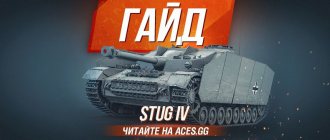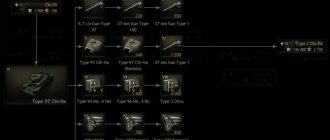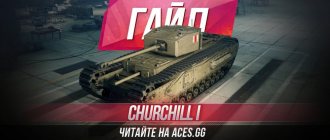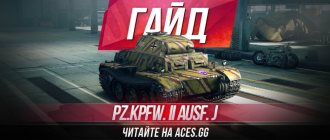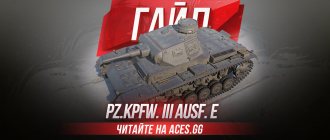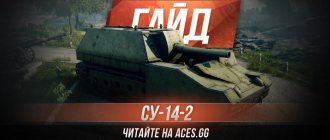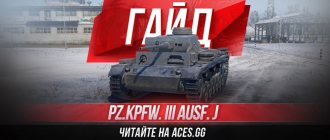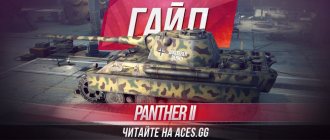Good day and welcome to aces.gg! Tankers, today our guest was an interesting and familiar vehicle to many, we are talking about a German tank destroyer of the fifth level - this is the StuG III Ausf. G guide
.
This device is familiar to many, as it is part of the popular line of German self-propelled guns, which ends with the famous Jg.Pz. E 100. But despite its fame, not many people know well what performance characteristics of the StuG III Ausf. G World of Tanks
you should rely on how to equip this machine and how to behave on it in battle for maximum effectiveness.
History of creation
The history of the third Stug began in 1935, when the idea arose to create an “assault artillery” vehicle to support infantry. There is a possibility that this idea was accidentally suggested to the Germans by the Russians while discussing with the Daimler-Benz company the creation of a prototype self-propelled gun for the Red Army. The sketch was even developed, but the Soviet side was not satisfied with the price, and the deal did not take place.
In 1936, they ordered the design of an armored vehicle to support infantry. It should have been armed with a 75 mm cannon, and also fully armored to protect the crew. At the same time, the height of the vehicle should have been no higher than the height of the average soldier.
Daimler-Benz decided to use the chassis of the Pz tank for development. III, then it was still quite new, and the gun was installed from the first modifications of the Pz. IV. After collecting several prototypes in 1937, they were sent to practice tactical techniques. But development took a lot of time, so the Sturmgeschütz III did not have time to take part in the Polish campaign, and only entered production in February 1940. But then they were modified and produced throughout the Second World War.
StuG III ausf A, first modification
TTX
general information
- Classification – assault weapon;
- Combat weight - 23.4 tons;
- Layout diagram - transmission compartment in front, engine compartment in the rear, controls and combat compartment in the center;
- Crew – 4 people;
- Years of development: 1937;
- Years of production – 1940-1945;
- Years of operation – 1940-1950;
- A total of 10,500 vehicles were produced.
Dimensions
- Hull length - 6770 mm, the same with the gun forward;
- Hull width – 2950 m;
- Height – 2950 mm;
- Ground clearance – 385 mm.
Booking
- Type of armor – cast and rolled steel;
- Body forehead, top - 25+30 / 85° mm/degree;
- Body side – 30 mm;
- Hull stern, top - 30 / 30° mm/degree;
- Bottom – 19 mm;
- Hull roof - 16/78-87° mm/degree;
- Cutting forehead - 50+30 / 9° mm/degree;
- Gun mask - 50+30 / 5° mm/degree;
- Cabin side - 30 / 0° + 8 / 30° mm/degree;
- Cabin roof - 10/78-90° mm/degree.
Armament
- Gun - Stuk 40 L/48 caliber 75 mm;
- Gun type - rifled;
- Barrel length - 24 caliber;
- Gun ammunition - 54 rounds;
- BH angles - −10...+20° degrees;
- GN angles – 12 degrees;
- Sights - Periscopic sights SfI ZF 1a and RbIF 36;
- Machine gun - MG 34 caliber 7.92 mm.
Mobility
- Engine type - V-shaped 12-cylinder carburetor, liquid-cooled;
- Engine power – 300 horsepower;
- Speed on highways and rough terrain – 38 km/h;
- Cruising range – 155 km;
- Specific power – 12.8 hp/t;
- Suspension type: Individual torsion bar, with hydraulic shock absorbers;
- Climbability – 30 degrees;
- The wall to be overcome is 0.6 m;
- The ditch to be overcome is 2.3 m;
- Fordability - 0.8 m.
We present to you the most formidable car in the second era in the German development branch, which, based on the totality of its characteristics, is the most dangerous for all its direct competitors. We meet – StuG III in modification F.
Characteristics of the StuG III Ausf. F
And immediately briefly about the characteristics of the StuG III Ausf. F. Weight – 22.5 tons. Engine power – 300 l/s. Maximum speed – 53 km/h. Reservation – 50/30/30 mm (front/sides/stern, respectively). The gun is the same as on the Pz.IV F2 - 75 mm KwK40 L43 with 54 rounds of ammunition. The vertical aiming angles downwards are 6 degrees, and upwards 17 degrees. We won’t focus on shells - everything is very good there already, and there’s no one to shoot at with top-caliber sub-caliber shells even in battles against tanks of the third era.
Tactics for using StuG III Ausf. F
Let's move from words to action and look at the main points of using this self-propelled gun in battles. The main advantage of our machine is the weapon, and the weapon is everything to us. And its competent implementation is one of the priority tasks in battle. There are several ways to accomplish this task. Let's start with the simplest thing, namely, supporting the allied forces from the second line of attack or defense. The main thing in this technique is not to get close to enemy forces and fire from medium and long distances, using information about the enemy’s location from allied tanks and the minimap. The rate of fire and flat trajectory of the projectiles make it possible to quickly take aim, and the armor penetration is enough to fight tanks at distances of over a kilometer. This tactic has one advantage. Let's imagine a situation where the allies you were covering were nevertheless destroyed and you are left against one or more opponents. In this case, the distance will again help us, which will allow us to gain time. And we will be able to retreat and organize an ambush for the enemy forces that have broken through - the terrain of most maps allows us to do this. And if after such maneuvers you cannot push back the attackers and organize a counterattack, then at least you can delay them until the allied tanks approach. But this technique also has its drawbacks. By staying away from the main theater of operations, you give the initiative to your opponent, and this, in turn, can lead to defeat in battle. And therefore, we move on to more aggressive tactical actions. Let's not forget that our self-propelled gun has an excellent maximum speed, using which we, along with medium tanks, can occupy key points. Having gained a foothold on which, firstly, being in more advantageous positions, we can destroy enemy armored vehicles. And, secondly, having destroyed the forces opposing us in this sector, we will be able to further develop our tactical success by organizing a breakthrough deep into the enemy’s defense.
Particular attention should be paid to the minimap. Whatever tactics you choose, by constantly observing the enemy’s movements, you will understand where the enemy is moving and in what numbers. And, accordingly, you will be able to perform maneuvers that will allow you to reach the flank of your target or, conversely, have time to move to a more advantageous position to meet the attacking forces. Also, an important part of a successful fight against armored vehicles is the choice of a priority target for attack. In most cases, these will be heavy KV tanks and their various modifications, since it is with them that your allies will have the greatest problems in destruction. That is, by disabling the most dangerous targets, you free up the hands of friendly forces who can switch to easier targets and, in such tandem, achieve victory together.
And according to tradition - a video review of the StuG III Ausf self-propelled gun. F and examples of its use in War Thunder:
Special thanks to Tredo for creating the video guide.
Share information with friends:
Modifications
The StuG III was used extensively throughout the war and was regularly modified to keep it relevant.
- Ausf.A is the first production vehicle based on the Pz.Kpfw.III Ausf.F chassis. 36 were created, 6 were converted from Pz.Kpfw.III Ausf.G. They were used in May-June 1940, later sent to training units;
- Ausf.B - similar to the previous model, but with wide track tracks and road wheels, with a manual transmission. 300 were built and used until the end of 1942;
- Ausf.C - with new bow armor, without a gunner's sight and with an updated design of the driver's hatch for extending the sight behind a closed one. 50 machines created;
- Ausf.D - similar to the previous version, but had an internal intercom. 150 vehicles were built, some converted into command vehicles;
- Ausf.E - an updated version, with additional armor. 284 vehicles were built, some converted into command vehicles, with the addition of stroboscopic instruments;
- Ausf.F (Sd.Kfz 142/1) - had even more reinforced armor and a different gun - 7.5 cm StuK 40 L/43. Due to this, it fought much more effectively against British and Soviet tanks. In 1942, 366 vehicles were created;
- Ausf.F/8 – a vehicle with the hull of the Pz.Kpfw.III Ausf.J tank and attached armor plates. 250 built;
- Ausf.G - the latest version of the Stug from MIAG and Alkett, was produced from 1942 to 1945. A total of 7,720 units were built. 142 were assembled on the Pz.Kpfw.III Ausf. chassis, another 173 were converted from Pz.Kpfw.III. The hull was the same as the previous model, but the armor was improved, the commander was given a turret with a periscope;
- StuH 42 - self-propelled gun with a 105 mm howitzer;
- StuG (Fl) is a self-propelled flamethrower created in 1943. Not many vehicles were assembled; according to documents, they were not used in battle, and in 1944 they were converted into the StuG III Ausf.G.
StuG III Ausf.G
German tank destroyer in World of Tanks – detailed guide to StuG III Ausf. G
27.02.2017
Good day to all!
We continue to get acquainted with the military equipment presented in World of Tanks.
Today we will look at a German tank destroyer of the fifth level.
Guide to StuG III Ausf. G will help you find out all the features of this self-propelled gun.
It is the German StuG that is most popular in World of Tanks. It is no coincidence that this self-propelled gun took a leading place in the game.
It was Germany that held the lead in the development of such military vehicles. In the gaming roundhouse, the rapid-fire and mobile “iron” of the tank destroyer drank a lot of blood from many players.
Want to know why? Read the review and everything will become clear to you.
A little historical background
During World War II, the StuG was the most popular German self-propelled gun. Its serial production lasted from 1940 to 1945. A serious claim to success was 8,636 copies of modifications with a long-barreled 75-mm cannon.
The concept of such a weapon was developed back in 1939. Self-propelled guns have always supported the infantry in the offensive. Initially, a new conning tower was developed based on the Pz-111 chassis with increased frontal armor to 50 mm and the installation of a short-barreled 75 mm cannon.
In 1942, its armor was increased to 80 mm, and the short gun was replaced by a long-barreled 43-caliber one. This significantly increased the anti-tank characteristics of the vehicle, and the modification itself became popular not only with the Germans, but also with the Soviet army.
Characteristics
In World of Tanks, the “iron” occupies a legitimate niche between assault and ambush self-propelled guns. Let's look at its technical characteristics from a gaming perspective.
- Protection . For the fifth level, the self-propelled gun has fairly decent armor - 80 mm in the forehead. However, it is still penetrated, since there are no rational inclinations of the frontal ammunition plates. It is necessary to keep a distance from the brawls of the tank destroyer, since it cannot boast of a health reserve (350 hit points). A plus is her low silhouette, so many projectiles pass her by.
- Firepower . StuG has a lot of guns. But the really interesting ones are the 10.5 cmStu.H. 42 L/28 and 7.5 cmPak 42 L/70. The first weapon has good one-time damage for an armor-piercing projectile (350 hit points) and 410 HP for landmines. The second gun is equipped with a basic 135 mm projectile, is very fast-firing, has a small dispersion and fast aiming. The first option is suitable for assault operations, the second - for remote shooting from cover.
- Dynamics . The top engine of the self-propelled gun is excellent. It allows you to accelerate to 40 km/h, giving you a complete feeling of freedom. The maximum load is increased by 3 tons by the StuG III Ausf. G. The turn is up to 47 degrees per second, so don’t even try to carousel it.
- Communication, detection . The overview is not encouraging - 310 meters, but you shouldn’t be surprised, everything is as it should be for a tank destroyer. Moreover, the low silhouette more than compensates for this disadvantage, making the “iron” invisible. As for the FuG 7 radio station, it allows you to communicate within a radius of up to 415 meters, and this is quite enough.
Equipment, pumping
Let's look at the order in which you should study the StuG III Ausf. G.
First of all, pump out the top tracks. This is necessary to accommodate the remaining modules. After this, take a 105-mm high explosive, sparing no experience (this will significantly increase the pumping several times).
Proceed to a thorough study of the radio station and engines. At the end, you finish off the top 75mm cannon.
For the crew, you upgrade the standard PT version. For the commander it is a “sixth sense”, for the rest it is “camouflage”.
After moving to the second level, you distribute profile perks to the crew, and complete the “green stuff” for the commander. At the third level you can already take on the “combat brotherhood”.
For the ambush option, the best setup would be the following option: “stereo tube”, “filler”, “camouflage net”. When active, select “ventilation” or “improved aiming drives”.
We take the classic consumables: “small repair kit”, “hand fire extinguisher”, “small first aid kit”.
Adviсe
The German "iron" is an excellent example of dual-use self-propelled guns. StuG can conduct offensive active operations and “kustrodrot”.
At the start, it is important to decide on ambush positions at the front line, then you can safely accelerate there. And immediately start shooting enemy fireflies.
If detected, retreat to reserve positions. Soon the infantry will begin to arrive and shooting will begin.
You just have to manage to fire and fire the shells. You release the first into the caterpillar, the second into the hull, and the third along the chassis. It's simple.
Never forget that you are fire support. If you are alone, then most likely you will be quickly merged.
Moreover, do not try to fight a heavy tank; for them, you are just enough prey. Only experienced gamers can fight a competent battle in splendid isolation.
Rejoice when you get to the TOP, your time has come. Now you can allow yourself to become the leader, since most of your opponents will not withstand your psychological and physical pressure.
You only need to be wary of the Hetzer with a 105 mm cannon and artillery.
Don't back up, don't forget that your reverse speed is only 10 km/h. It's better to huddle and rush forward.
If you have reached the end of the battle, the most enjoyable moment will begin - shooting wounded animals. In this, your tank destroyer is unrivaled.
Retreat to the base if there are more enemies than allies, and observe the capture circle at the chosen position. Start from here to destroy all lovers of bloodless victories.
Advantages:
- Excellent dynamics and speed.
- Great damage per minute.
- Various types of weapons.
- Good disguise.
Flaws
- A short review.
- Poor health, weak armor.
- Small ammunition.
- Slow reverse.
German StuG III Ausf. G is suitable for both fans of rapid flanking maneuvers and those who like to sit out in the bushes.
For tank destroyers in World of Tanks, the fifth level is the most comfortable in terms of raiding and farming.
And it is StuG that is the undoubted leader here. Try it and you will be amazed - your statistics will begin to grow by leaps and bounds.
Good luck to all!
Vehicles based on Stug III
- Munitionspanzer auf StuG 40 Ausf. G – ammunition transporter. It did not have a cannon; sometimes a crane was placed on the roof to make it easier to load and unload ammunition. Was not very widespread;
- In the Soviet Union, several dozen SU-76Is were made from captured Stugs, with a higher deckhouse and inclined armor plates. The vehicles were actively used in 1943-1944, although captured StuG IIIs often fought on the side of the Red Army without modifications.
SU-76I
Combat use
The StuG III first saw action in Holland and France in the spring and summer of 1940. Overall they performed well, but it became clear that in order to effectively support the infantry the number of Stug units would need to be increased.
Typically, the Stugs were made up of batteries - six vehicles each, among which were combat self-propelled guns and a command half-track armored vehicle Sd.Kfz.253, as well as an ammunition transporter Sd.Kfz.252.
By the end of autumn 1940, enough Stugs had been produced to create divisions. During this period they fought in Yugoslavia and Greece, and the Germans had only lost one Sturmgeschutz III before the Eastern Front campaign.
After 1941
In 1941, the situation changed seriously, and units with Stugs began to suffer losses, although their number in the army only increased due to active production. StuG III fought in Africa in 1942, and after the defeat at El Alamein they lost almost all of their self-propelled guns.
The StuG.III Ausf.F/8, specially prepared for desert conditions, was sent to Naples at the beginning of 1942, and then to Tunisia, where they actively fought, but eventually surrendered to the Allies.
Of course, the third Stuga actively participated in Operation Barbarossa, and in fairly large numbers. Then they constantly fought on the Eastern Front - they were mainly modification B vehicles. They were quite effective in storming fortified areas. Tanks and anti-tank guns of the Red Army had difficulty penetrating frontal armor, and the low silhouette made it difficult to hit. So by the end of 1941, the Wehrmacht had lost less than a hundred self-propelled guns on the Eastern Front. Around the same time, captured StuG IIIs began to be used by the Red Army.
StuG III Ausf E captured by the Soviet Army
The StuG III/40 played a very important role in the third assault on Sevastopol, after which the city fell. It was the Stug crews who broke through to the Panorama building and planted the flag of the Third Reich on it. True, losses in this battle were also heavy.
The Germans lost many Stugs during the Battle of Stalingrad. After this, the batteries began to be equipped with vehicles of various modifications, adding StuН 42 to effectively combat field fortifications.
455 StuG III/40 took part in the Battle of Kursk. Quite a lot of cars were lost, many of them beyond repair. At the same time, Soviet troops began to create the SU-76I from captured Stugs, but they soon stopped doing this in favor of their self-propelled guns due to the unstable flow of trophies and complex repairs.
In 1944-1945, the German military industry could no longer produce enough Stugs to make up for their losses - the factories were destroyed by Allied aircraft. So in the end, by the end of World War II, very few of these machines remained.
In general, the StuG III self-propelled gun, according to experts, turned out to be very successful. It effectively fought tanks from ambush thanks to its low silhouette, and its armor allowed it to destroy enemy tanks much earlier than the enemy could knock out the self-propelled gun itself.
After World War II, StuG III was actively used in the Middle East and some European countries. The last military action in which the Stugs participated was the Six Day War of 1967.
Destroyed StuG III
Application
StuG III is one of the most successful tank destroyers in Germany. Thanks to the choice of two excellent weapons, it can perform various tasks in battle. With a 75-mm gun, the self-propelled gun turns into an excellent ambush sniper - this is facilitated by accuracy, high armor-piercing power and stealth. Poor visibility makes playing with this tactic somewhat difficult, but after installing a stereo tube, this disadvantage is partially leveled out.
With a 105mm gun, the StuG III becomes even more dangerous at medium and close ranges. This weapon can also be used from an ambush, but the most effective are risky raider tactics: rapid movements from cover to cover, flanking and shooting at the enemy’s side, and quick retreat when threatened. Quick turning and acceleration, as well as excellent top speed, allow the Stug to move quickly across the battlefield.
With all this, it is important to remember: going into close combat is extremely risky - despite the nominally good frontal armor, it is 80 mm only on a few small parts of the forehead with small angles of inclination, so the armor almost does not work against tanks of levels 5-7, and the safety margin enough for literally 2-4 shots from classmates. You can fight in close combat only in a group of heavy or medium tanks, behind which you can always take cover. It is highly not recommended to “shine” in front of Soviet TTs of levels 6-7 (KV-1S, IS), since they destroy the StuG III with one shot. Therefore, in the event of close clashes with the enemy, it is necessary to attack those tanks that are engaged in battle and distracted by the allies, as well as use shelters on the ground and in the city in order to avoid return fire.
Due to its good turning speed, the StuG III is very difficult to spin, which, coupled with its high rate of fire, makes it great for hunting down enemy scouts. Among the secondary disadvantages of self-propelled guns, one can note the low reverse speed. Often the Stug simply does not have time to return to cover after being shot and is destroyed. In this regard, it is necessary to correctly calculate time and your own capabilities. For example, in a difficult situation it is often possible to catch an enemy by surprise by rushing at him instead of slowly backing away. Slow tanks, such as the KV-1, are often unprepared for such a turn of events; they are easy to spin. Such maneuvers close to the enemy are risky, but in some cases they can gain time or even destroy the enemy.
Tank in culture
The Stug 3 can be found in several games dedicated to World War II and tanks, for example, Behind Enemy Lines, Company of Heroes 2 and, of course, World of Tanks and War Thunder.
The car is also widely represented in bench modeling - plastic prefabricated models are produced in China, Japan and Russia.
Model StuG III from Zvezda
The best tank in World of Tanks for beginners and more
When I started my gaming career in WoT, there were no French, British and Japanese tanks yet. Then there was the era of German cubism and Soviet simplicity. Many believed that the best tank in World of Tanks at the initial levels was the KV-1. Yes, it was a powerful machine, but today I want to talk about the “stealth killer” - the Stug III Ausf. G.
Strengths of the Stug III Ausf. G
Even in today's reality of the dominance of tank drums and fast maneuverable vehicles, the Stug III can show good results. And bring silver to the treasury. Buckets. This tank destroyer has the following advantages:
- fast acceleration to maximum speed – 40 km/h.
- maneuverable - no light tank can spin us around;
- rapid-fire, armor-piercing and accurate weapon;
- excellent camouflage.
Proper use of the advantages of a tank allows you to create miracles on the battlefield. Moreover, it doesn’t matter whether we hit the top or the bottom - we can always deal decent damage. I often manage to deal more damage than some level sevens.
Correct tactics
The Stug III can be equipped with one of two top guns: a 105mm high explosive and a 75mm hole puncher. Some people prefer to ride with a high explosive, but with it it is difficult to realize their main advantage - stealth.
Therefore, we choose 75mm. The weapon penetrates all enemies up to level 7. Problems can only arise with the frontal armor of the strands.
At one time I fought on this Stuga against the 8th level - even there were suitable targets.
Top Stug III guns
Stug III is an ambush tank. Therefore, we stay behind our allies and deal damage when they are visible. Notice that I didn’t say that you need to sit at the base and study all the surrounding trees and bushes.
It is better to gradually advance after the attacking column and choose convenient positions. This way they won’t see us, which means they won’t destroy us - Stug cannot boast of excellent health.
Don’t forget to study the map and use your speed - this way we will end up where we need it.
Crew upgrades and modules for Stug 3 G
To unleash the capabilities of the Stug III, you need a pumped-up crew. The most important skill is camouflage. After it we study the “sixth sense”, “sniper”, “virtuoso”.
Thanks to the stealth of the vehicle, opponents will only be able to see us closely. The same KV-2 is just a thick and clumsy target for us. All he can do is move his 152mm muzzle in bewilderment.
I recommend these modules:
- ventilation;
- camouflage net;
- rammer.
After upgrading the crew, the network can be replaced with a stereo tube - a review will not be superfluous.
Memory of a tank
Not many StuG IIIs have survived to this day. Running vehicles are in the Parola Tank Museum in Finland, as well as in the private collection of John Phillips. Non-functional tanks are exhibited in France, Finland, Sweden, and Bulgaria. They are also in Russia - in the Kubinka Tank Museum and in the Museum of the Great Patriotic War in Moscow. These are mainly cars of the Ausf, G modification.
StuG III Ausf.G in Kubinka
TTX StuG III Ausf. G
First of all, everyone who rolled this German into battle should know that he has at his disposal a very modest margin of safety, although standard for a PT-5. In addition, the StuG III Ausf. G WoT
the visibility indicator is one of the worst on the level - only 310 meters.
In terms of survivability, this device can surprise quite often. First of all, this German woman has compact and very down-to-earth dimensions, due to which a high stealth coefficient is achieved, that is, it is not easy to detect us and we will hide behind any stone.
If you look at what StuG III Ausf. G characteristics
booking, everything is also very decent. The strongest part of the tank is the so-called VLD; this small threshold, thanks to its good slope, reaches a thickness of 133 millimeters, which allows you to often catch ricochets from classmates’ guns.
As for the NLD and the front of the cabin, most of the surfaces here have a thickness of 81-88 millimeters, that is, you will be penetrated here very often. However, the tank destroyer StuG III Ausf. G World of Tanks
there is also a large and very mysterious gun mantlet. Its thickness varies from a measly 50 millimeters to a very serious 151 millimeters.
In other words, you need to play with this vehicle carefully and preferably against camouflage, but in difficult situations the German tank StuG III Ausf. G
It is capable of delighting its owner with a mass of ricochets, however, it is still not worth hoping for this and also - never show your loose sides to the enemy, the thickness of the armor here is very meager.
Regarding the vehicle's driving characteristics, it boasts an excellent horsepower-per-ton ratio and impressive maneuverability, but the maximum forward speed of the StuG III Ausf. G tank
it is rather weak (you won’t be able to accelerate very much) and moves backward extremely poorly, which is also very important in battle.
Photo and video
StuG III Ausf.B
StuG III Ausf. C
StuG III Ausf.D
StuG III Ausf.F (Sd.Kfz 142/1)
StuG III Ausf.F/8
StuG III Ausf.E
StuG III StuG (Fl), flame-resistant
StuH 42
StuG III cross-section More material on the topic
- M4 Sherman
- New deadly tank T90MS
gun
As in the case of the Hetzer tank destroyer, our self-propelled gun has at its disposal two completely different guns for the owner to choose from; of course, it’s worth talking about each weapon option.
First, let's look at the StuG III Ausf. B gun
with a caliber of 75 millimeters, so to speak, a reliable and stable option. This gun has a decent alpha strike by the standards of its classmates, but the rate of fire is not its strong feature, which is why it deals about 1,700 units of damage per minute. This indicator is not so bad, but it is also small.
The penetration of this gun is quite good, using only armor-piercing shells, StuG III B tank
can confidently beat all his classmates and almost all A's. But for fifth level heavies and most sixes you will have to buy gold supplies.
In terms of accuracy, this gun is good, since with it the StuG III Ausf. B
gets a compact dispersion and fast aiming, while poor stabilization will not bother you, you will practically not notice it, unless you try to shoot right away.
As for the aiming angles, in our case they leave much to be desired in both weapon options. The negative declination angle is only 6 degrees, and the horizontal aiming angles of the StuG III Ausf. B WoT
a total of 20 degrees, which is also not very good.
The second weapon is a howitzer, or, in tanker slang, a high explosive, which has high one-time damage, allowing you to one-shot your classmates in the event of a complete penetration.
The problem is that the penetration here is low, that is, it is normal to fight the StuG III Ausf. World of Tanks
can only be at the top of the list. You will deal little damage to armored vehicles and most sixth levels, of course, if they do not expose the stern.
As expected, the accuracy of this barrel is also mediocre, the spread is large, there is still no stabilization, but now the aiming is no longer so fast, which somewhat complicates the process of causing damage.
Based on the results, I want to say that the German tank StuG III B
It is better to place the first cannon, since you will often have to fire from afar, and in this case you need increased accuracy and penetration. It is with this configuration in mind that we will continue this guide, that is, highlight the pros and cons, choose equipment, perks, etc.
